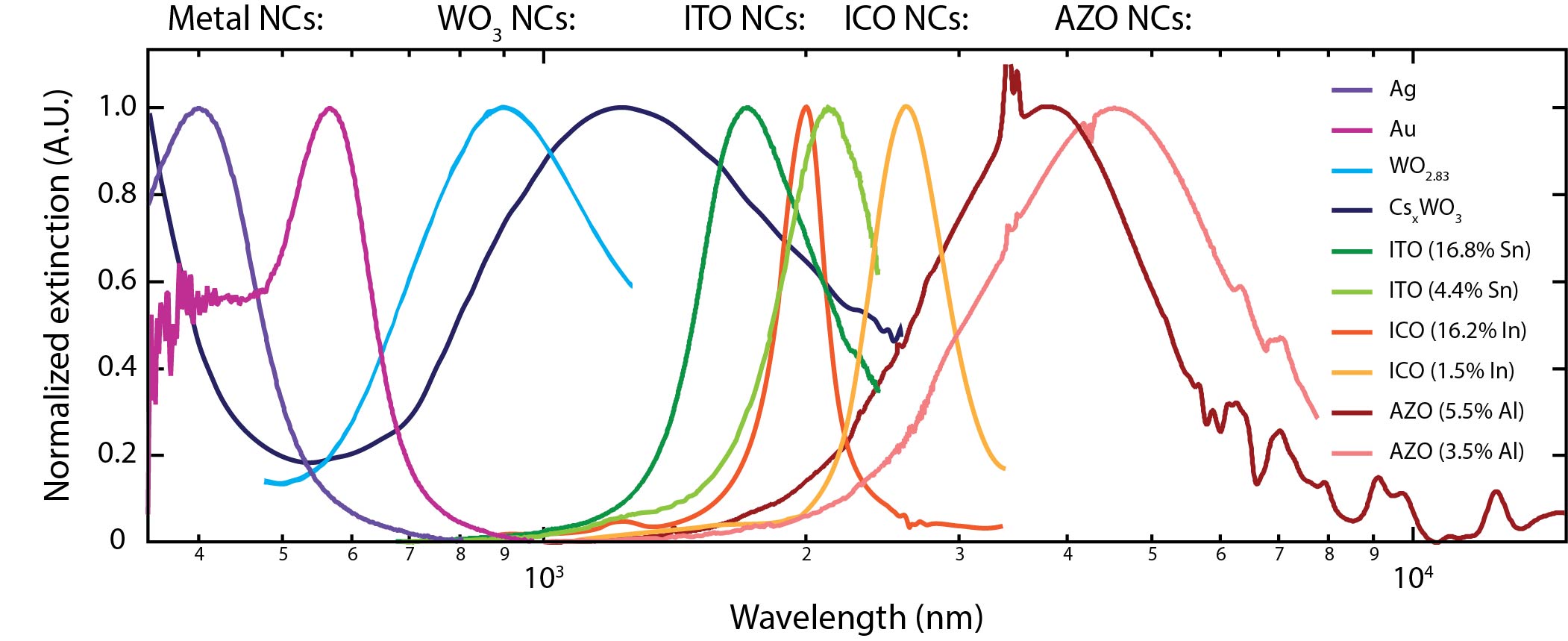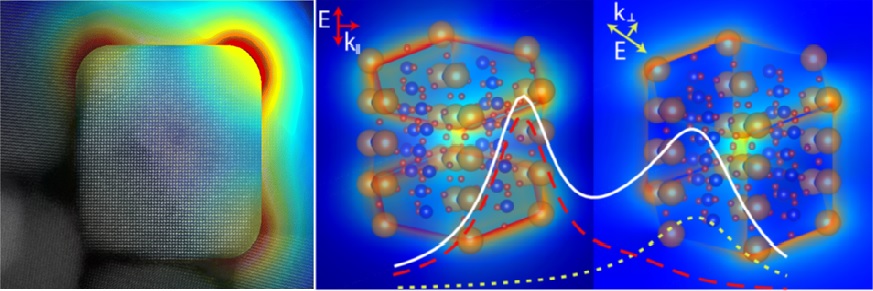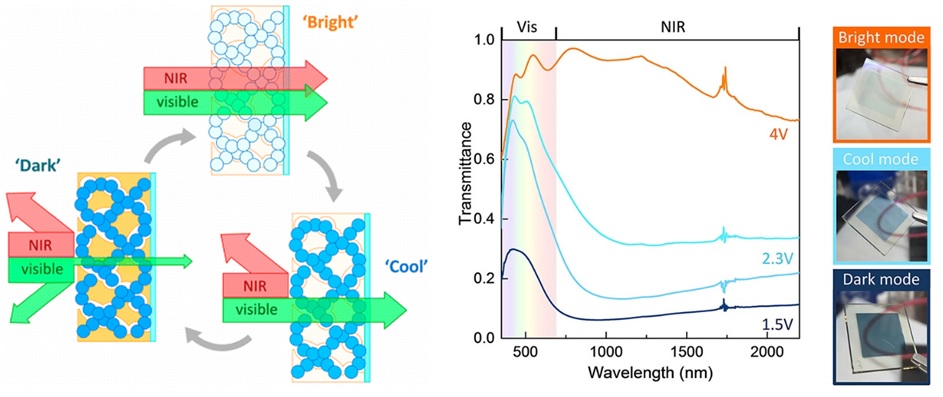
Semiconductor Nanocrystal Plasmonics

Normalized optical extinction due to LSPRs in solutions and films of metal and metal oxide nanocrystals [1].
Semiconductor nanocrystals with variable free carrier density (1018-1022/cm3) can support collective oscillations of charge in response to electromagnetic radiation. These nanostructures exhibit enhanced absorption and scattering when free carrier oscillations are in resonance with light, and localized by nanocrystal geometry and dielectric environment, due to the localized surface plasmon resonance (LSPR) effect. The Milliron group studies the synthesis of doped metal oxide nanocrystals and their plasmonic properties [1] to understand how compositional and structural factors influence the LSPR across the visible and infrared ranges of light [1].

Cerium-doped indium oxide (Ce:In2O3) nanocrystals display mid-infrared LSPR with exceptionally narrow line widths [3]. LSPR band-splitting into two distinct peaks in cesium-doped tungsten oxide (Cs:WO3) is modeled taking into account the anisotropic dielectric function due to crystalline anisotropy [5,6].
Our synthetic studies focus on controlling nanocrystal size, shape, crystallinity and the distribution of dopants and defects to impact the plasmonic response. In contrast to the LSPR in metals, interstitially or substitutionally localized dopants in metal oxides provide extended LSPR tunability across the IR spectrum. For instance, we have demonstrated the synthesis of tin-doped indium oxide (ITO) nanocrystals with surface segregated dopants which generate more symmetric and narrow plasmonic line shapes compared to nanocrystals with uniformly distributed dopants [2]. Defect engineering through cerium-doped indium oxide (Ce:In2O3) nanocrystals display tunable mid-infrared LSPR with exceptionally narrow line widths due to reduction in ionized impurity scattering [3].

Transmittance spectra and sample photos of a dual-band electrochromic film composed of WO3-x-NbOx composite. Different coloration states correspond to different Li+ ion charging potentials [6].
In order to characterize such nuanced plasmonic behavior, standard VIS-NIR and FTIR spectroscopies for ensemble measurements along with synchrotron scattering-scanning near-field optical microscopy (S-SNOM) capable of probing single particle LSPR response is used [4]. Experimental observations are integrated with multi-scale theoretical models (e.g. Drude models) and simulations [5, 6] to coordinate the design of new materials with targeted LSPR properties and unravel surface depletion effects unique to classes of doped nanocrystals [7]. The ability to dynamically control the LSPR offers a unique opportunity to develop novel photonic systems and optoelectronic devices. Currently, reversible tuning of the LSPR is achieved electrochemically via charging and discharging of nanocrystal films. The tunable IR-plasmonic electrochromism obtained in this way has been useful for making efficient spectrally-selective energy saving smart windows [8,9].
Related papers:
[1] A Agrawal, SH Cho, O Zandi, S Ghosh, RW Johns, and DJ Milliron. “Localized Surface Plasmon Resonance in Semiconductor Nanocrystals,” Chem. Rev., 118 (2018), 3121–3207 [link]
[2] SD Lounis, EL Runnerstrom, A Bergerud, D Nordlund, and DJ Milliron. “Influence of Dopant Distribution on the Plasmonic Properties of Indium Tin Oxide Nanocrystals,” J. Am. Chem. Soc., 136, 19 (2014), 7110-7116 [link]
[3] EL Runnerstrom, A Bergerud, A Agrawal, RW Johns, CJ Dahlman, A Singh, SM Selbach, and DJ Milliron. “Defect Engineering in Plasmonic Metal Oxide Nanocrystals,” Nano Lett., 16, (2016), 3390–3398 [link]
[4] Robert W. Johns, Hans A. Bechtel, Evan L. Runnerstrom, Ankit Agrawal, Sebastien D. Lounis, and Delia J. Milliron. “Direct observation of narrow mid-infrared plasmon linewidths of single metal oxide nanocrystals,” Nature Comm., 7, (2016), 11583 [link]
[5] A Agrawal, I Kriegel, and DJ Milliron. “Shape-Dependent Field Enhancement and Plasmon Resonance of Oxide Nanocrystals,” J. Phys. Chem. C, 119, 11 (2015), 6227-6238 [link]
[6] Jongwook Kim, Ankit Agrawal, Franziska Krieg, Amy Bergerud, and Delia J. Milliron. “The Interplay of Shape and Crystalline Anisotropies in Plasmonic Semiconductor Nanocrystals,” Nano Lett., 16, (2016), 3879-3884 [link]
[7] O Zandi, A Agrawal, AB Shearer, LC Reimnitz, CJ Dahlman, CM Staller, and DJ Milliron. “Impacts of Surface Depletion on the Plasmonic Properties of Doped Semiconductor Nanocrystals,” Nature Mat., 17, (2018), pages710–717 [link]
[8] A Llordes, G Garcia, J Gazquez, DJ Milliron. “Tunable Near-Infrared and Visible Light Transmittance in Nanocrystal-in-Glass Composites,” Nature, 500, (2013), 323-326 [link]
[9] J Kim, GK Ong, Y Wang, G LeBlanc, TE Williams, TM Mattox, BA Helms, DJ Milliron. “Nanocomposite Architecture for Rapid, Spectrally-Selective Electrochromic Modulation of Solar Transmittance,” Nano Lett., 15, (2015), 5574-5579 [link]